Pu Wang
Frank
Synthetic Tabular Data Generation: A Comparative Survey for Modern Techniques
Jul 15, 2025Abstract:As privacy regulations become more stringent and access to real-world data becomes increasingly constrained, synthetic data generation has emerged as a vital solution, especially for tabular datasets, which are central to domains like finance, healthcare and the social sciences. This survey presents a comprehensive and focused review of recent advances in synthetic tabular data generation, emphasizing methods that preserve complex feature relationships, maintain statistical fidelity, and satisfy privacy requirements. A key contribution of this work is the introduction of a novel taxonomy based on practical generation objectives, including intended downstream applications, privacy guarantees, and data utility, directly informing methodological design and evaluation strategies. Therefore, this review prioritizes the actionable goals that drive synthetic data creation, including conditional generation and risk-sensitive modeling. Additionally, the survey proposes a benchmark framework to align technical innovation with real-world demands. By bridging theoretical foundations with practical deployment, this work serves as both a roadmap for future research and a guide for implementing synthetic tabular data in privacy-critical environments.
UHD Image Dehazing via anDehazeFormer with Atmospheric-aware KV Cache
May 20, 2025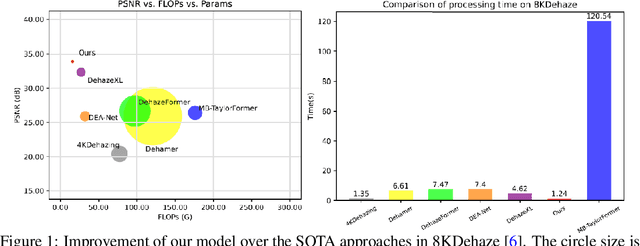



Abstract:In this paper, we propose an efficient visual transformer framework for ultra-high-definition (UHD) image dehazing that addresses the key challenges of slow training speed and high memory consumption for existing methods. Our approach introduces two key innovations: 1) an \textbf{a}daptive \textbf{n}ormalization mechanism inspired by the nGPT architecture that enables ultra-fast and stable training with a network with a restricted range of parameter expressions; and 2) we devise an atmospheric scattering-aware KV caching mechanism that dynamically optimizes feature preservation based on the physical haze formation model. The proposed architecture improves the training convergence speed by \textbf{5 $\times$} while reducing memory overhead, enabling real-time processing of 50 high-resolution images per second on an RTX4090 GPU. Experimental results show that our approach maintains state-of-the-art dehazing quality while significantly improving computational efficiency for 4K/8K image restoration tasks. Furthermore, we provide a new dehazing image interpretable method with the help of an integrated gradient attribution map. Our code can be found here: https://anonymous.4open.science/r/anDehazeFormer-632E/README.md.
Towards Reliable and Interpretable Traffic Crash Pattern Prediction and Safety Interventions Using Customized Large Language Models
May 18, 2025Abstract:Predicting crash events is crucial for understanding crash distributions and their contributing factors, thereby enabling the design of proactive traffic safety policy interventions. However, existing methods struggle to interpret the complex interplay among various sources of traffic crash data, including numeric characteristics, textual reports, crash imagery, environmental conditions, and driver behavior records. As a result, they often fail to capture the rich semantic information and intricate interrelationships embedded in these diverse data sources, limiting their ability to identify critical crash risk factors. In this research, we propose TrafficSafe, a framework that adapts LLMs to reframe crash prediction and feature attribution as text-based reasoning. A multi-modal crash dataset including 58,903 real-world reports together with belonged infrastructure, environmental, driver, and vehicle information is collected and textualized into TrafficSafe Event Dataset. By customizing and fine-tuning LLMs on this dataset, the TrafficSafe LLM achieves a 42% average improvement in F1-score over baselines. To interpret these predictions and uncover contributing factors, we introduce TrafficSafe Attribution, a sentence-level feature attribution framework enabling conditional risk analysis. Findings show that alcohol-impaired driving is the leading factor in severe crashes, with aggressive and impairment-related behaviors having nearly twice the contribution for severe crashes compared to other driver behaviors. Furthermore, TrafficSafe Attribution highlights pivotal features during model training, guiding strategic crash data collection for iterative performance improvements. The proposed TrafficSafe offers a transformative leap in traffic safety research, providing a blueprint for translating advanced AI technologies into responsible, actionable, and life-saving outcomes.
AgentPolyp: Accurate Polyp Segmentation via Image Enhancement Agent
Apr 15, 2025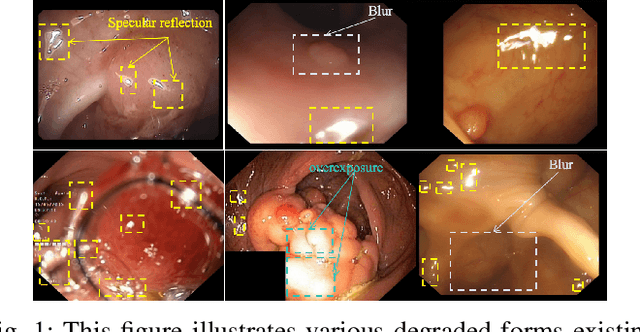
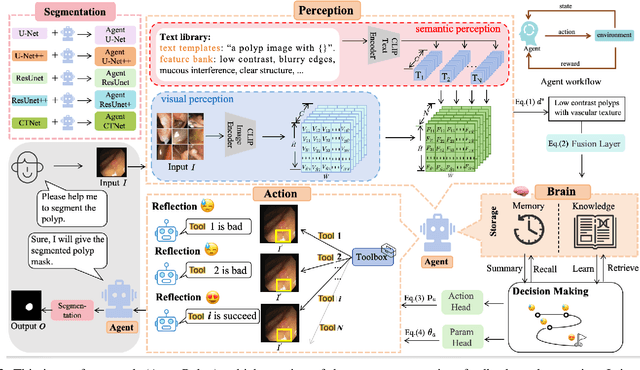
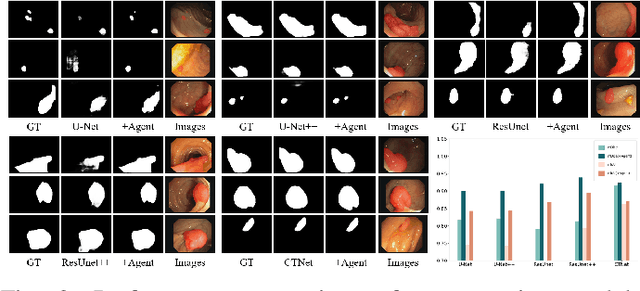

Abstract:Since human and environmental factors interfere, captured polyp images usually suffer from issues such as dim lighting, blur, and overexposure, which pose challenges for downstream polyp segmentation tasks. To address the challenges of noise-induced degradation in polyp images, we present AgentPolyp, a novel framework integrating CLIP-based semantic guidance and dynamic image enhancement with a lightweight neural network for segmentation. The agent first evaluates image quality using CLIP-driven semantic analysis (e.g., identifying ``low-contrast polyps with vascular textures") and adapts reinforcement learning strategies to dynamically apply multi-modal enhancement operations (e.g., denoising, contrast adjustment). A quality assessment feedback loop optimizes pixel-level enhancement and segmentation focus in a collaborative manner, ensuring robust preprocessing before neural network segmentation. This modular architecture supports plug-and-play extensions for various enhancement algorithms and segmentation networks, meeting deployment requirements for endoscopic devices.
DanceMosaic: High-Fidelity Dance Generation with Multimodal Editability
Apr 06, 2025Abstract:Recent advances in dance generation have enabled automatic synthesis of 3D dance motions. However, existing methods still struggle to produce high-fidelity dance sequences that simultaneously deliver exceptional realism, precise dance-music synchronization, high motion diversity, and physical plausibility. Moreover, existing methods lack the flexibility to edit dance sequences according to diverse guidance signals, such as musical prompts, pose constraints, action labels, and genre descriptions, significantly restricting their creative utility and adaptability. Unlike the existing approaches, DanceMosaic enables fast and high-fidelity dance generation, while allowing multimodal motion editing. Specifically, we propose a multimodal masked motion model that fuses the text-to-motion model with music and pose adapters to learn probabilistic mapping from diverse guidance signals to high-quality dance motion sequences via progressive generative masking training. To further enhance the motion generation quality, we propose multimodal classifier-free guidance and inference-time optimization mechanism that further enforce the alignment between the generated motions and the multimodal guidance. Extensive experiments demonstrate that our method establishes a new state-of-the-art performance in dance generation, significantly advancing the quality and editability achieved by existing approaches.
UAKNN: Label Distribution Learning via Uncertainty-Aware KNN
Apr 02, 2025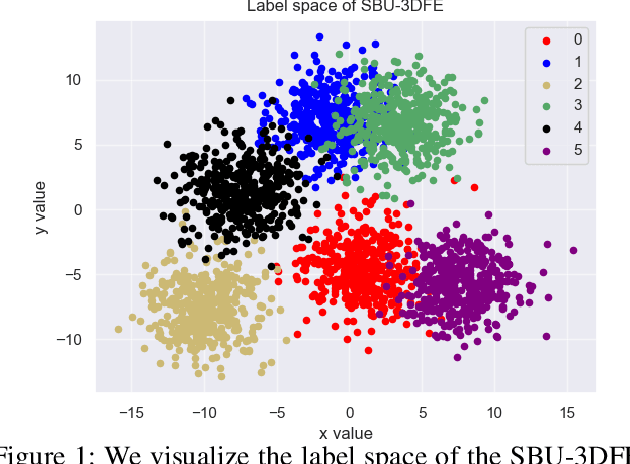
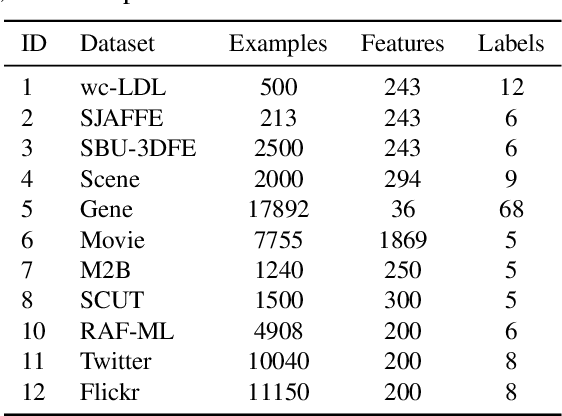
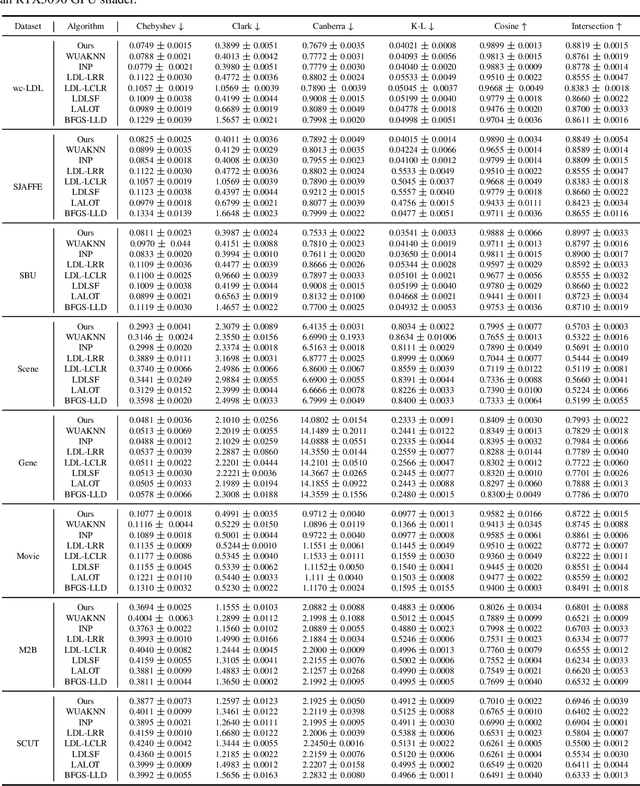
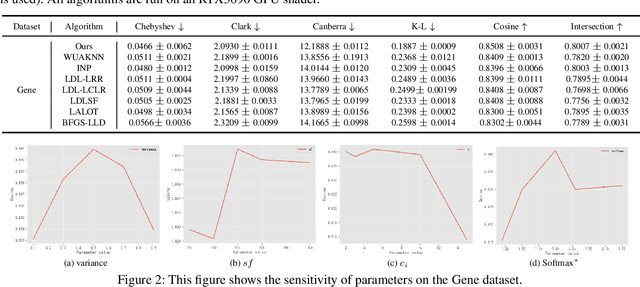
Abstract:Label Distribution Learning (LDL) aims to characterize the polysemy of an instance by building a set of descriptive degrees corresponding to the instance. In recent years, researchers seek to model to obtain an accurate label distribution by using low-rank, label relations, expert experiences, and label uncertainty estimation. In general, these methods are based on algorithms with parameter learning in a linear (including kernel functions) or deep learning framework. However, these methods are difficult to deploy and update online due to high training costs, limited scalability, and outlier sensitivity. To address this problem, we design a novel LDL method called UAKNN, which has the advantages of the KNN algorithm with the benefits of uncertainty modeling. In addition, we provide solutions to the dilemma of existing work on extremely label distribution spaces. Extensive experiments demonstrate that our method is significantly competitive on 12 benchmarks and that the inference speed of the model is well-suited for industrial-level applications.
PolypFlow: Reinforcing Polyp Segmentation with Flow-Driven Dynamics
Feb 26, 2025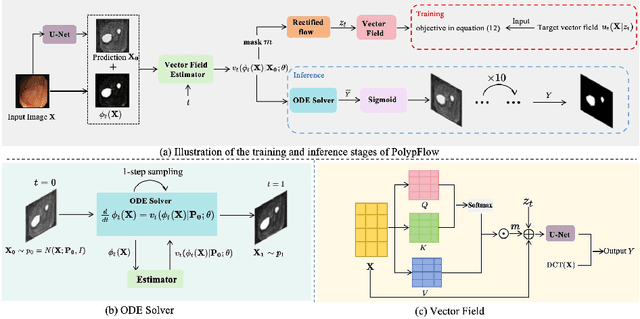


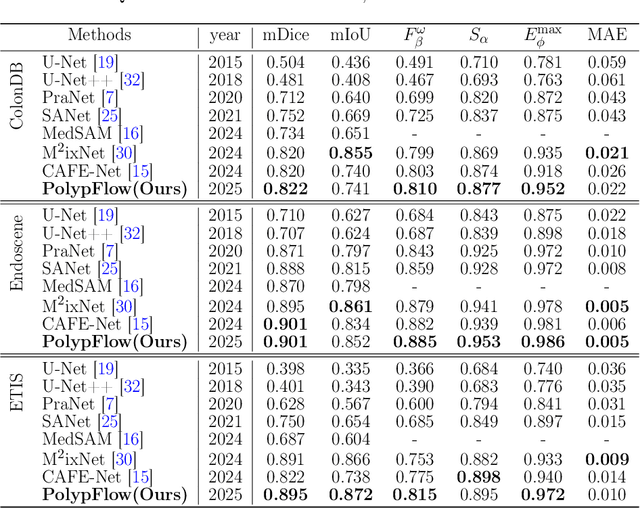
Abstract:Accurate polyp segmentation remains challenging due to irregular lesion morphologies, ambiguous boundaries, and heterogeneous imaging conditions. While U-Net variants excel at local feature fusion, they often lack explicit mechanisms to model the dynamic evolution of segmentation confidence under uncertainty. Inspired by the interpretable nature of flow-based models, we present \textbf{PolypFLow}, a flow-matching enhanced architecture that injects physics-inspired optimization dynamics into segmentation refinement. Unlike conventional cascaded networks, our framework solves an ordinary differential equation (ODE) to progressively align coarse initial predictions with ground truth masks through learned velocity fields. This trajectory-based refinement offers two key advantages: 1) Interpretable Optimization: Intermediate flow steps visualize how the model corrects under-segmented regions and sharpens boundaries at each ODE-solver iteration, demystifying the ``black-box" refinement process; 2) Boundary-Aware Robustness: The flow dynamics explicitly model gradient directions along polyp edges, enhancing resilience to low-contrast regions and motion artifacts. Numerous experimental results show that PolypFLow achieves a state-of-the-art while maintaining consistent performance in different lighting scenarios.
SKI Models: Skeleton Induced Vision-Language Embeddings for Understanding Activities of Daily Living
Feb 05, 2025



Abstract:The introduction of vision-language models like CLIP has enabled the development of foundational video models capable of generalizing to unseen videos and human actions. However, these models are typically trained on web videos, which often fail to capture the challenges present in Activities of Daily Living (ADL) videos. Existing works address ADL-specific challenges, such as similar appearances, subtle motion patterns, and multiple viewpoints, by combining 3D skeletons and RGB videos. However, these approaches are not integrated with language, limiting their ability to generalize to unseen action classes. In this paper, we introduce SKI models, which integrate 3D skeletons into the vision-language embedding space. SKI models leverage a skeleton-language model, SkeletonCLIP, to infuse skeleton information into Vision Language Models (VLMs) and Large Vision Language Models (LVLMs) through collaborative training. Notably, SKI models do not require skeleton data during inference, enhancing their robustness for real-world applications. The effectiveness of SKI models is validated on three popular ADL datasets for zero-shot action recognition and video caption generation tasks.
mmCooper: A Multi-agent Multi-stage Communication-efficient and Collaboration-robust Cooperative Perception Framework
Jan 21, 2025Abstract:Collaborative perception significantly enhances individual vehicle perception performance through the exchange of sensory information among agents. However, real-world deployment faces challenges due to bandwidth constraints and inevitable calibration errors during information exchange. To address these issues, we propose mmCooper, a novel multi-agent, multi-stage, communication-efficient, and collaboration-robust cooperative perception framework. Our framework leverages a multi-stage collaboration strategy that dynamically and adaptively balances intermediate- and late-stage information to share among agents, enhancing perceptual performance while maintaining communication efficiency. To support robust collaboration despite potential misalignments and calibration errors, our framework captures multi-scale contextual information for robust fusion in the intermediate stage and calibrates the received detection results to improve accuracy in the late stage. We validate the effectiveness of mmCooper through extensive experiments on real-world and simulated datasets. The results demonstrate the superiority of our proposed framework and the effectiveness of each component.
BioPose: Biomechanically-accurate 3D Pose Estimation from Monocular Videos
Jan 14, 2025Abstract:Recent advancements in 3D human pose estimation from single-camera images and videos have relied on parametric models, like SMPL. However, these models oversimplify anatomical structures, limiting their accuracy in capturing true joint locations and movements, which reduces their applicability in biomechanics, healthcare, and robotics. Biomechanically accurate pose estimation, on the other hand, typically requires costly marker-based motion capture systems and optimization techniques in specialized labs. To bridge this gap, we propose BioPose, a novel learning-based framework for predicting biomechanically accurate 3D human pose directly from monocular videos. BioPose includes three key components: a Multi-Query Human Mesh Recovery model (MQ-HMR), a Neural Inverse Kinematics (NeurIK) model, and a 2D-informed pose refinement technique. MQ-HMR leverages a multi-query deformable transformer to extract multi-scale fine-grained image features, enabling precise human mesh recovery. NeurIK treats the mesh vertices as virtual markers, applying a spatial-temporal network to regress biomechanically accurate 3D poses under anatomical constraints. To further improve 3D pose estimations, a 2D-informed refinement step optimizes the query tokens during inference by aligning the 3D structure with 2D pose observations. Experiments on benchmark datasets demonstrate that BioPose significantly outperforms state-of-the-art methods. Project website: \url{https://m-usamasaleem.github.io/publication/BioPose/BioPose.html}.
 Add to Chrome
Add to Chrome Add to Firefox
Add to Firefox Add to Edge
Add to Edge